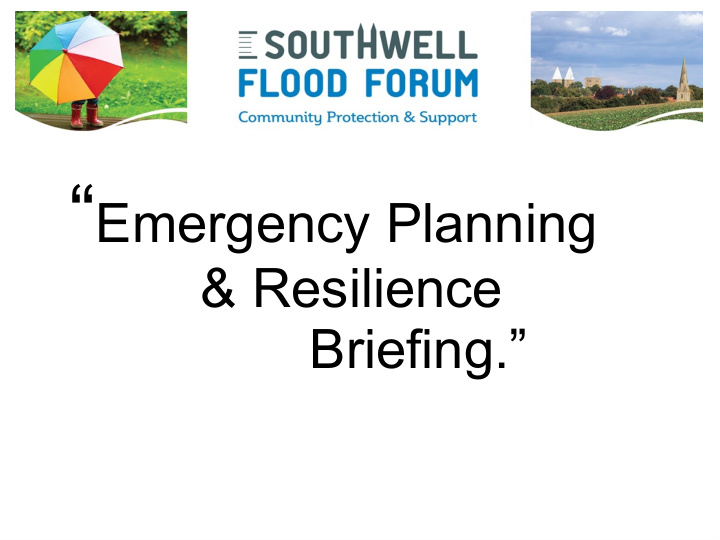



“ Emergency Planning & Resilience Briefing.”
Aim “To offer an brief insight into Southwell Flood Forum Flood Resilience Planning and Training”.
Objectives • The Road Closure Scheme, wardens and training • Household preparedness • Communications Hub
Flood signage and Road Closure scheme Delivered by NCC’s Robert Fisher & VIA’s Mike Greenaway
Why is the scheme needed? Bow waves Danger to motorists
Process Identification of problem areas Recruitment of volunteers Production / approval of policy document Establish appropriate triggers Risk assessments Training (Water safety, sign positioning & manual handling, Road closure o briefing and preparedness) Training – specific Handover of road signs Ongoing refresher training
Signs / Equipment Flood Warning sign Road Ahead Closed Road Closed
8 Road Closures, currently with dedicated wardens and each with two or more sets of signs. Westgate 1. Nottingham Road 2. Church Street/ Easthorpe 3. Newark Road 4. Halam Road 5. Kirklington Road 6. Lower Kirklington Road 7. Station Road 8.
Water Safety Delivered by Nottinghamshire Fire & Rescue Service
It is essential to know what is under your feet.
A little closer!
Same place without the water!
A little closer!!
Preparedness Delivered by David Sheard SFF
Lon ong ter term m plan planning. • Self sufficiency • Flood defenses. • Know where they are and how to use them • Smoke Alarms. • Working and in the right location • Insurance cover. • In place and information available • Sign up for Flood and weather alerts. • Keep informed • Network of neighbours. • Especially those that are vulnerable..
Where are important contact details kept? School? Child-minder? Work? Relatives? Utilities? Insurance?
Write it down Examples to download from websites - EA (flooding), Police (general emergency)
Communications Hub Southwell Community Emergency plan Communications Hub protocol Really important • Central point of communication in the Town during and after any emergency situation • Meeting point for volunteers to help with emergency • Act as a focal point for Category 1 responders • Obtain on the ground feedback for Cat 1 • Support Road Closure Wardens • Provide advice, information and assistance to visitors • Take calls from residents..
Road Closure Scheme Communications Hub Protocol Road Closure Policy Weather event forecasted NCC (VIA) Reopen Roads Wardens on Standby Communications Hub on Road Closure Trigger Met NCC informed Standby Emergency planning (Communications established ) Communications Hub Informed of road closures Communications Hub Road closures (Up and running) protocol initiated Communications maintained as Road Closure wardens monitor the situation Public & Community Emergency Stand-down Potential use as Emergency Services Control room transport companies (Liaison with VIA to collect signs + informed debrief)
What next? • Dry run for road closure scheme 18th &19th May • Resilience education, Local scouts and guide groups • Duke of Edinburgh Bronze award, 3 month skills or volunteer sections. • Anyone interested signing up as a flood road closure warden, please speak to Jacky.
In the words of Bob Marley “Some people feel the rain, others just get wet”. Any Questions?.
Civil Contingencies Act 2004 Part 1 of the Act and supporting Regulations and statutory guidance ‘Emergency preparedness’ establish a clear set of roles and responsibilities for those involved in emergency preparation and response at the local level. The Act divides local responders into 2 categories, imposing a different set of duties on each. Those in Category 1 are organisations at the core of the response to most emergencies (the emergency services, local authorities, NHS bodies). They will be required to: • assess the risk of emergencies occurring and use this to inform contingency planning • put in place emergency plans • put in place business continuity management arrangements • put in place arrangements to make information available to the public about civil protection matters and maintain arrangements to warn, inform and advise the public in the event of an emergency • share information with other local responders to enhance co-ordination • co-operate with other local responders to enhance co-ordination and efficiency • provide advice and assistance to businesses and voluntary organisations about business continuity management (local authorities only)
• Category 2 organisations (the Health and Safety Executive, transport and utility companies) are ‘co-operating bodies’. They are less likely to be involved in the heart of planning work, but will be heavily involved in incidents that affect their own sector.
Recommend
More recommend